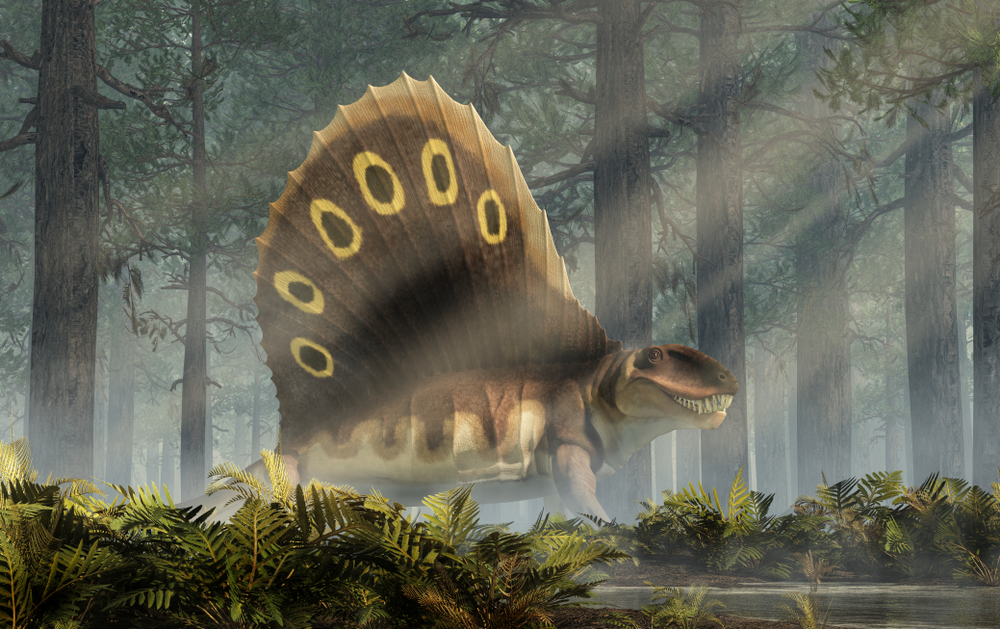Dimetrodon, a Giant Sail-Finned Predator, Was More Related to Mammals than Dinosaurs
Posted on Categories Discover Magazine

Dimetrodon was the largest predator of its time, preying on giant amphibians nearly 300 million years ago during the Early Permian period.
“They were eating basically whatever they wanted,” says Kirstin Brink, a paleontologist at the University of Manitoba in Canada who studies these creatures.
But these ancient sail-finned creatures have often been misunderstood throughout history and were incorrectly classified as dinosaurs for some of the past 150 years. The Dimetrodon were instead more closely related to mammals than dinosaurs, birds, and surviving reptiles.
The Dimetrodon Discovery
Dimetrodon was thought to be one of the oldest dinosaurs discovered in the world when a man found part of an upper jaw in Prince Edward Island in 1845. The holotype specimen was named Bathygnathus borealis.
The trouble is, Bathygnathus borealis wasn’t a dinosaur at all. In fact, it’s from a different evolutionary branch of vertebrates. While dinosaurs, birds, and modern-day reptiles are all Sauropsids, Brink and her colleagues helped reclassify Bathygnathus borealis as a Synapsid — a large clade of vertebrates that eventually gave rise to mammals.
“We are actually closer related to Dimetrodon than any other reptile is,” Brink says, though Dimetrodons likely aren’t direct ancestors of mammals.
Due to the better understanding of these creatures, Brink and her colleagues recently helped to rename Bathygnathus borealis to Dimetrodon borealis — an unusual step as the older name in taxonomy is usually preferred.
“We suggest a reversal of precedence is required to preserve the familiar name Dimetrodon and to maintain universality, thus recognizing the new species Dimetrodon borealis,” Brink and her colleagues wrote in the study published in 2015 in the Canadian Journal of Earth Sciences.
The number of Dimetrodons discovered increased over the years to at least 14 species, Brink says, though the classification is “still a bit of a mess” as some classified as distinct species may just be juveniles of other species.
Read More: A Complete Dinosaur Timeline to Extinction: How Long Did They Roam Earth?
What Did Dimetrodon Look Like?
While not related to them, Dimetrodons did look a little like lizards. The biggest of this genus, Dimetrodon grandis, were likely more than 2 meters in length.
The Giant Sail Fin
The standout feature of Dimetrodon species has also been a point of dispute between paleontologists over the years. These creatures all had large sail-like fins rising from their backs, that stretched roughly from their necks to the base of their tails. Unlike basilisk lizards or sailfin dragons, which have similarly large fins today, Dimetrodon’s crests weren’t flexible.
Some scientists believe that the sail acted as a kind of giant solar panel. Dimetrodons might have oriented it to the sun to gather heat while basking. The trouble is, Brink says, that some researchers had cut open some of the fossilized sails and didn’t find spaces for blood vessels — what you’d need to effectively use it as a warming tool. Some near cousins in the fossil record, Sphenacodon, had similar body proportions but lacked sails, which made Brink think the Dimetrodons didn’t need them to warm up.
“It maybe suggests that they weren’t using it just for thermoregulation,” she says.
Other experts think the sails were colorfully adorned, which Dimetrodons may have used for camouflage. If not, the colors may have been used as sexual signaling, to attract potential mates, or for intimidating potential foes, Brink says. The trouble is, none of the color pigments of these creatures have survived in fossils, so it’s hard to be certain.
“The sail was definitely confusing, and I think it still is confusing,” Brink says.
Dimetrodon Teeth
In a more recent study published in Nature Communications, Brink analyzed the teeth of Dimetrodon fossils. The teeth mostly had a blade shape, but some of the more recent fossils were longer in the gums, and some adapted a serrated edge.
All Dimetrodons would have been carnivorous, though the smaller ones may have been insectivorous. During the Early Permian when these creatures first lived, they were preying on other carnivores. The prey of early Dimetrodons may have included creatures like Diplocaulus, one of the earliest amphibians, or Eryops.
But as time went on, their prey base may have increased. During the Permian, we see the development of the first herbivorous vertebrates, Brink says, which would have provided ample prey for Dimetrodons.
Read More: How Do Scientists Reconstruct What Dinosaurs Looked Like?
The End Permian Extinction
The good times didn’t last for Dimetrodon, as it didn’t for most life on the planet. According to the fossil record, the Dimetrodon genus went extinct around the end of the Cisuralian epoch in the Permian.
The creatures were certainly all gone by the End Permian extinction event 252 million years ago, a series of extinction pulses that together formed perhaps the largest extinction of life on the planet.
Read More: The Permian Extinction: Life on Earth Nearly Disappeared During the ‘Great Dying’
Article Sources
Our writers at Discovermagazine.com use peer-reviewed studies and high-quality sources for our articles, and our editors review for scientific accuracy and editorial standards. Review the sources used below for this article:
Joshua Rapp Learn is an award-winning D.C.-based science writer. An expat Albertan, he contributes to a number of science publications like National Geographic, The New York Times, The Guardian, New Scientist, Hakai, and others.